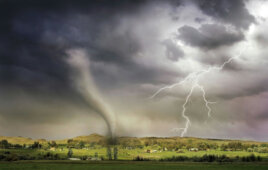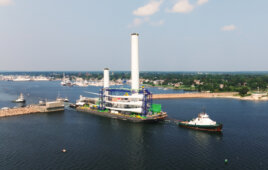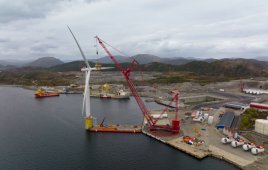After growing steadily since 2005 at a compound annual growth rate of 32%, the U.S. wind market experienced its first drop in annual additions, declining 50% in 2010. This according to a study by consulting firm IHS EER. The drop reflects fewer power opportunities—a result of low natural-gas prices, transmission bottlenecks in key wind markets, and limited state Renewable Portfolio Standard demand.
Despite declines in the cost of wind energy over the past two years, it is difficult for wind to compete with natural gas at current price

The chart highlights transaction costs for over 50 wind projects based on PPAs signed between 2007 and 2010 relative to average wholesale power prices in the US.
levels. During the run up in natural gas prices, which peaked at $13/million Btus in 2008, wind was economically competitive with gas as a new source of power generation in an expanding power market. But as U.S. power demand weakened and the supply of available natural gas continued to rise, natural gas prices have plummeted to average less than $4/million Btus in 2009 and have been only slightly above that mark in 2010. The significant price declines have significantly eroded the economic argument to build wind, making it increasingly difficult for developers to secure power purchase agreements (PPAs), and all but eliminating the ability to attain financing to build merchant wind projects.
The accompanying graphic highlights transaction costs for over 50 wind projects based on PPAs signed between 2007 and 2010 relative to average wholesale power prices in the US. Renewable PPA prices peaked in December 2008 along with increasing gas prices. However, as market conditions deteriorated, PPAs signed by wind developers have fallen over 30% on average, lagging the trend in wholesale power prices by roughly six months. The trend of falling PPA prices is expected to continue through 2011, as a highly competitive market place, weak demand for new power, and increased shale gas production will keep downward pressure on prices.
The chart represents projects online between 2007 and 2010 with contracts executed between January 2007 and June 2010. Omitted are projects online during the same period but with earlier contract execution dates. Prices represent realized price for full year 2010, where available, excluding test energy or other pre-COD arrangements. The wholesale power price taken as monthly median of representative sample of US hubs Source: FERC, Intercontinental Exchange, EIA, IHS Emerging Energy Research Regional Wind
Increased competition across a widening number of states looking to add renewables to their generation mix is creating a fragmented pricing market for wind power.
Another illustrations in the report show regional variations in power market fundamentals, wind siting conditions, and RPS demand intensity are creating significant regional differences in wind transaction pricing.
The report authors at IHS EER have modeled the likely impact of a Clean Energy Standard (CES) on demand for renewables relative to existing state RPS targets. This is based on the assumption that a CES would require 15% of total US generation to come from new sources of clean energy by 2025—similar to a number of bills debated in Congress over the last several years. If a CES passes, it would most significantly impact the near-term opportunity for development of renewables in states without existing RPS targets, largely in the southeastern US. This would create over 220 TWh of incremental demand from eligible clean sources, a nearly 50% increase over current demand required by all state RPS policies in 2025. In the longer term, a CES would create a relatively stable mandate for utilities and regulators to adopt strategies to steadily increase renewables into their supply mix.
Adapting to market conditions, developers and independent power producers (IPPs) have shifted the geographic focus of their near-term pipelines, modified their development plans, or are increasingly looking toward acquisitions for growth. IPPs continue to be the driving force of U.S. wind development, capturing 90% of 2010 additions, but utilities are expected to gain market share as RPS demand ramps up.
Aside from top IPPs, geographic shifts in wind project development are occurring throughout the industry. As heightened transmission congestion and weak demand have strained growth in perennial development hot spots including Texas, Iowa, and Minnesota, developers continue to prospect states with less-prolific resources but greater RPS demand and available transmission capacity.
IHS EER
Filed Under: Featured




